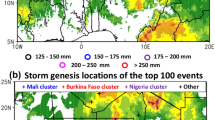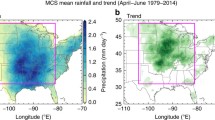Abstract
Heavy rainfall events in austral summer are responsible for almost all the natural disasters in Southeast Brazil. They are mostly associated with two types of atmospheric perturbations: Cold Front (53%) and the South Atlantic Convergence Zone (47%). The important question of what synoptic characteristics distinguish a heavy rainfall event (HRE) from a normal rainfall event (NRE) is addressed in this study. Here, the evolutions of such characteristics are identified through the anomalies with respect to climatology of the composite fields of atmospheric variables. The anomalies associated with HRE are significantly more intense than those associated with NRE in all fundamental atmospheric variables such as outgoing long-wave radiation, sea-level pressure, 500-hPa geopotential, lower and upper tropospheric winds. The moisture flux convergence over Southeast Brazil in the HRE composites is 60% larger than in the NRE composites. The energetics calculations for the HRE that occurred in the beginning of February 1988 strongly suggest that the barotropic instability played an important role in the intensification of the perturbation. These results, especially the intensities of the wind, pressure anomalies, and the moisture convergence are useful for the meteorologists of the Southeast Brazil for forecasting heavy precipitation.








Similar content being viewed by others
Abbreviations
- CF:
-
Cold front
- SACZ:
-
South Atlantic convergence zone
- ANA:
-
Agência Nacional das Águas
- CPTEC:
-
Centro de Previsão de Tempo e Estudos Climáticos
- NRE:
-
Normal rainfall events
- HRE:
-
Heavy rainfall events
- SEB:
-
Southeast Brazil
- SP:
-
São Paulo
- RJ:
-
Rio de Janeiro
- MG:
-
Minas Gerais
- ES:
-
Espírito Santo
- GNP:
-
Gross national product
- NDJFM:
-
November, December, January, February, and March
- NCEP-NCAR:
-
National Centers for Environmental Prediction-National Center for Atmospheric Research
- PDO:
-
Pacific decadal oscillation
- OLR:
-
Outgoing long-wave radiation
- SLP:
-
Sea-level pressure
- q :
-
Specific humidity
- u :
-
Zonal wind component
- v :
-
Meridional wind component
- W :
-
Omega
- Z :
-
Geopotential
- AZ:
-
Zonal available potential energy
- AE:
-
Eddy available potential energy
- KZ:
-
Zonal kinetic energy
- KE:
-
Eddy kinetic energy
References
Bluestein HB (1993) Synoptic-dynamic meteorology in midlatitudes. Vol II—observations and theory of weather systems. Oxford University Press, Oxford 594
Carvalho LMV, Jones C, Liebmann B (2002) Extreme precipitation events in southern South America and large-scale convective patterns in the South Atlantic Convergence Zone. J Clim 15:2377–2394
Grimm AM, Canestraro CD (2003) Interdecadal oscillations in southeastern South America and their relationship with sea surface temperature. Abstracts in International Symposium on Climate Change (ISCC), Pequim China, 166
Harrison DE, Larkin NK (1998) El Niño–Southern oscillation sea surface temperature and wind anomalies. Rev Geophysics 36:353–399
Herdies DL, Da Silva A, Silva Dias MAF, Nieto-Ferreira R (2002) Moisture budget of the bimodal pattern of the summer circulation over South America. J Geo Res 107:8075. doi:10.1029/2001JD000997
Kalnay E et al (1996) The NCEP/NCAR 40-year reanalysis project. Bull Amer Meteor Soc 77:437–471
Kodama Y-M (1992) Large-scale common features of sub-tropical precipitation zones (the Baiu Frontal Zone, the SPCZ, and the SACZ). Part I: characteristics of subtropical frontal zones. J Meteor Soc Japan 70:813–835
Krishnamurti TN, Lahouari B (1995) An introduction to numerical weather prediction techniques. CRC ISBN: 0849389100 p 30
Liebmann B, Jones C, Carvalho LMV (2001) Interannual variability of daily extreme precipitation events in the state of São Paulo, Brazil. J Clim 14:208–218
Nogués-Paegle J, Mo KC (1997) Alternating wet and dry conditions over South America during summer. Mon Wea Rev 125:279–291
Oliveira AS (1986) Interações entre sistemas frontais na América do Sul e a convecção da Amazônia (in Potuguese, abstract in English). MSc Dissertation (Available at Instituto Nacional de Pesquisas Espaciais, São José dos Campos, 12227-010, SP, Brazil)
Rao VB, Hada K (1990) Characteristics of rainfall over Brazil: annual variations and connections with the Southern Oscillation. Theor Appl Climatol 42:81–91
Revista Climanálise, Edited by Instituto Nacional de Pesquisas Espaciais (INPE), Brazil, year 1986 to 2005. Available at: http://www.cptec.inpe.br/products/climanalise/
Satyamurty P, Nobre CA, Silva Dias PL (1998) Tropics: South America. meteorology of the Southern Hemisphere. Amer Meteor Soc 40:119–139
Seluchi EM, Chou SC (2009) Synoptic patterns associated with landslide events in the Serra do Mar, Brazil. Theor Appl Climatol 101:1–11
Silva Dias PL, Marengo JA (1999) Águas Atmosféricas. Águas Doces do Brasil. Ed. IAE/USP:65-116
Smith JA, Baeck ML, Steiner M (1996) Catastrophic rainfall from an upslope thunderstorm in the central Appalachians: the rapid storm of June 27, 1995. Water Resour Res 32:3099–3113
Teixeira MS, Satyamurty P (2007) Dynamical and synoptic characteristics of heavy rainfall episodes in Southern Brazil. Mon Wea Rev 135:598–617
Wilks DS (1995) Statistical methods in the atmospheric sciences: an introduction. Academic, p 470
Acknowledgments
The first author was supported by the National Council of Scientific and Technological Development (CNPQ: Conselho Nacional de Desenvolvimento Científico e Tecnológico), Brazil. The second author is an Amazon Senior Fellow of the Foundation of the Support to Research of the State of Amazonas (FAPEAM: Fundação de Amparo à Pesquisa do Estado do Amazonas). The authors thank Dr. José Paulo Bonatti and Dra. Renata Weissmann Borges Mendonça for their help in the energetic calculations. The authors thank the anonymous reviewers who have contributed to the improvement of the manuscript.
Author information
Authors and Affiliations
Corresponding author
Rights and permissions
About this article
Cite this article
Lima, K.C., Satyamurty, P. & Fernández, J.P.R. Large-scale atmospheric conditions associated with heavy rainfall episodes in Southeast Brazil. Theor Appl Climatol 101, 121–135 (2010). https://doi.org/10.1007/s00704-009-0207-9
Received:
Accepted:
Published:
Issue Date:
DOI: https://doi.org/10.1007/s00704-009-0207-9




